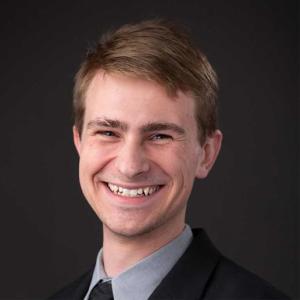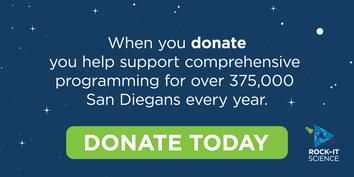Craveology Cafe and the North Star Science Store are temporarily closed for renovation.
Matthew Martens

Living things of all shapes, sizes, and classifications have always fascinated me. Growing up in rural Nebraska, I had no shortage of interesting creatures to occupy my interest. From frogs and snakes to birds of prey and mammals, I continually found myself enraptured with the wildly different ways in which these animals survive in an ever-changing world. Hiking in the lush hills and grasslands of my home state, I had the opportunity to experience so many of these unique organisms, stopping frequently to take a closer look at nearly every turn.
When I learned about microscopic organisms in an early biology class, I was immediately intrigued. Invisible to the naked eye and intimately intertwined with humans, these small—but incredibly impactful—organisms play a crucial role in shaping our lives, and I knew that I wanted to learn as much about them as I could. With the unwavering support of my wonderful parents, I was able to work with a local group collecting swabs from amphibians at risk of fatal fungal infections. I found these pathogenic microbes to be incredibly interesting, and soon my interests expanded to those that cause human diseases. After enrolling in college, graduate school, and eventually my postdoctoral training, I studied a variety of microbes, from the parasite Toxoplasma gondii to fungal pathogens and many things between.
However, this period proved to be much more impactful than I could have ever known. From a young age, I had always felt a certain distance from the norm, but I could never quite pinpoint the reason. As time passed, I began to piece together the truth: I was, and am, gay. For such a long time, I repressed this identity, fearing the difficulties that public disclosure would entail. I was afraid of the ways that they would treat me, of what it would mean for my daily life. Yet, one day, I found that I could no longer hide this reality. At that time, in my early 20s, I finally made the decision to come out—and felt such an incredible relief. I was whole for the first time, even being so different than my peers.
It certainly hasn’t been an easy path as a gay microbiologist, with new and unexpected difficulties facing me. I lost friends and felt isolated at times. There are still those in science who, despite their success, are unable to accept LGBTQIA+ identities, and I experienced this firsthand. But, over time, I was incredibly fortunate in finding amazing support from my communities, and that has made a fundamental difference in my life. I’ve now found my identity, both scientifically and personally, and I have never felt more content in myself.
Los seres vivos de todas las formas, tamaños y clasificaciones siempre me han fascinado. Al crecer en la zona rural de Nebraska, no me faltaron criaturas interesantes para ocupar mi interés. Desde ranas y serpientes hasta aves rapaces y mamíferos, me encontraba continuamente embelesado con las formas salvajemente diferentes en que estos animales sobreviven en un mundo en constante cambio. Caminando por las exuberantes colinas y praderas de mi estado natal, tuve la oportunidad de experimentar muchos de estos organismos únicos, deteniéndome con frecuencia para observar más de cerca y a cada paso.
Cuando aprendí sobre los organismos microscópicos en una primera clase de biología, quedé intrigado de inmediato. Invisibles a simple vista e íntimamente entrelazados con los humanos, estos organismos pequeños, pero increíblemente impactantes, juegan un papel crucial en la configuración de nuestras vidas, y ahí supe que quería aprender tanto como pudiera sobre ellos. Con el apoyo inquebrantable de mis maravillosos padres, pude trabajar con un grupo local recolectando hisopos de anfibios en riesgo de infecciones fatales por hongos. Encontré que estos microbios patógenos eran increíblemente interesantes y pronto mis intereses se expandieron a aquellos que causan enfermedades humanas. Después de inscribirme en la universidad, la escuela de posgrado y, finalmente, en mi formación posdoctoral, estudié una variedad de microbios, desde el parásito Toxoplasma gondii hasta patógenos de los hongos y muchas cosas intermedias.
Sin embargo, este período resultó ser mucho más impactante de lo que me hubiera podido imaginar. Desde muy joven, siempre había sentido una cierta distancia de la norma, pero nunca pude precisar la razón. A medida que pasaba el tiempo, comencé a reconstruir la verdad: era y soy gay. Durante tanto tiempo, reprimí esta identidad, temiendo las dificultades que implicaría la divulgación pública. Tenía miedo de la forma en que me tratarían, de lo que significaría para mi vida diaria. Sin embargo, un día, descubrí que ya no podía ocultar esta realidad. En ese momento, cuando tenía poco más de 20 años, finalmente tomé la decisión de salir del clóset y sentí un alivio increíble. Estaba completo por primera vez, incluso siendo tan diferente a mis compañeros.
Ciertamente no ha sido un camino fácil el de microbiólogo gay, con nuevas e inesperadas dificultades que me enfrentaban. Perdí amigos y me sentí aislado a veces. Todavía hay personas en la ciencia que, a pesar de su éxito, no pueden aceptar las identidades LGBTQIA+, y lo experimenté de primera mano. Pero, con el tiempo, fui increíblemente afortunado de encontrar un apoyo espectacular de mis comunidades, y eso marcó una diferencia fundamental en mi vida. Ahora he encontrado mi identidad, tanto científicamente como personalmente, y nunca me he sentido más contento conmigo mismo.
